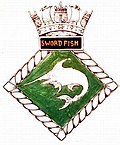HMS Swordfish (61S)
 HMS Swordfish
| |
| History | |
|---|---|
| Name | HMS Swordfish |
| Builder | Chatham Dockyard |
| Laid down | 1 December 1930 |
| Launched | 10 November 1931 |
| Commissioned | 28 November 1932 |
| Fate | Sunk by mine 7 November 1940 |
| Badge |  |
| General characteristics | |
| Class and type | S-class submarine |
| Displacement |
|
| Length | 202 ft 6 in (61.72 m) |
| Beam | 24 ft (7.3 m) |
| Draught | 10 ft 6 in (3.20 m) |
| Propulsion | Twin diesel/electric |
| Speed |
|
| Complement | 36 officers and men |
| Armament |
|
HMS Swordfish (61S) was a group one British S-class submarine that was sunk on a combat patrol in the English Channel in November 1940 during the Second World War.
Design and description
The S-class submarines were designed as successors to the L class and were intended to operate in the North and Baltic Seas.[1] The submarines had a length of 202 feet 6 inches (61.7 m) overall, a beam of 24 feet (7.3 m) and a mean draft of 11 feet 11 inches (3.6 m). They displaced 730 long tons (740 t) on the surface and 927 long tons (942 t) submerged.[2] The S-class submarines had a crew of 38 officers and ratings. They had a diving depth of 300 feet (91.4 m).[3]
For surface running, the boats were powered by two 775-brake-horsepower (578 kW) diesel engines, each driving one propeller shaft. When submerged each propeller was driven by a 650-horsepower (485 kW) electric motor. They could reach 13.75 knots (25.47 km/h; 15.82 mph) on the surface and 10 knots (19 km/h; 12 mph) underwater.[4] On the surface, the first-batch boats had a range of 3,700 nautical miles (6,900 km; 4,300 mi) at 10 knots (19 km/h; 12 mph) and 64 nmi (119 km; 74 mi) at 2 knots (3.7 km/h; 2.3 mph) submerged.[3]
The boats were armed with six 21-inch (533 mm) torpedo tubes in the bow. They carried six reload torpedoes for a grand total of a dozen torpedoes. They were also armed with a 3-inch (76 mm) deck gun.[2]
Construction and career
Swordfish was laid down by Chatham Dockyard. The boat was launched on 10 November 1931.[2]
At the onset of the Second World War, Swordfish was a member of the 2nd Submarine Flotilla. From 23-26 August 1939 the 2nd Submarine Flotilla moved to their war bases at Dundee and Blyth.[5]
Nothing was heard from her following her departure from Portsmouth on 7 November 1940 with 40 crew on board to relieve HMS Usk which was on patrol off the Western Approaches near Brest, France. At the time it was thought that she had been sunk by a German destroyer.[6] However she was discovered by a local diver in 1983, split into two just forward of the gun by a mine.[7][8] The wreck lies in about 46 metres of water roughly 12 miles south of St. Catherine’s Point, Isle of Wight.[9] It is likely that she struck the mine shortly after sailing whilst carrying out a trim dive. The wreck site is designated as a protected place[10] under the Protection of Military Remains Act 1986.
See also
References
Citations
- ^ Harrison, Chapter 16
- ^ a b c Chesneau, p. 49
- ^ a b McCartney, p. 4
- ^ Bagnasco, p. 110
- ^ Rohwer, p.1
- ^ Submarine losses 1904 to present day, RN Submarine Museum, Gosport
- ^ *Innes McCartney (2002). Lost Patrols: Submarine Wrecks of the English Channel.
- ^ Disappearance of HMS Swordfish, Isle of Wight index
- ^ HMS Swordfish, Uboot.net
- ^ "Statutory Instrument 2008/0950". Office of Public Sector Information, 1 April 2008. Retrieved 2008-07-19.
Sources
- Bagnasco, Erminio (1977). Submarines of World War Two. Annapolis, Maryland: Naval Institute Press. ISBN 0-87021-962-6.
- Colledge, J. J.; Warlow, Ben (2006) [1969]. Ships of the Royal Navy: The Complete Record of all Fighting Ships of the Royal Navy (Rev. ed.). London: Chatham Publishing. ISBN 978-1-86176-281-8.
- Chesneau, Roger, ed. (1980). Conway's All the World's Fighting Ships 1922–1946. Greenwich, UK: Conway Maritime Press. ISBN 0-85177-146-7.
- Harrison, A. N. (January 1979). "The Development of HM Submarines From Holland No. 1 (1901) to Porpoise (1930) (BR3043)". Submariners Association: Barrow in Furness Branch. Retrieved 19 August 2015.
- McCartney, Innes (2006). British Submarines 1939–1945. New Vanguard. Vol. 129. Oxford, UK: Osprey. ISBN 1-84603-007-2.
- Rohwer, Jürgen (2005). Chronology of the War at Sea 1939—1945: The Naval History of World War Two (Revised & Expanded ed.). Annapolis, Maryland: Naval Institute Press. ISBN 1-59114-119-2.
